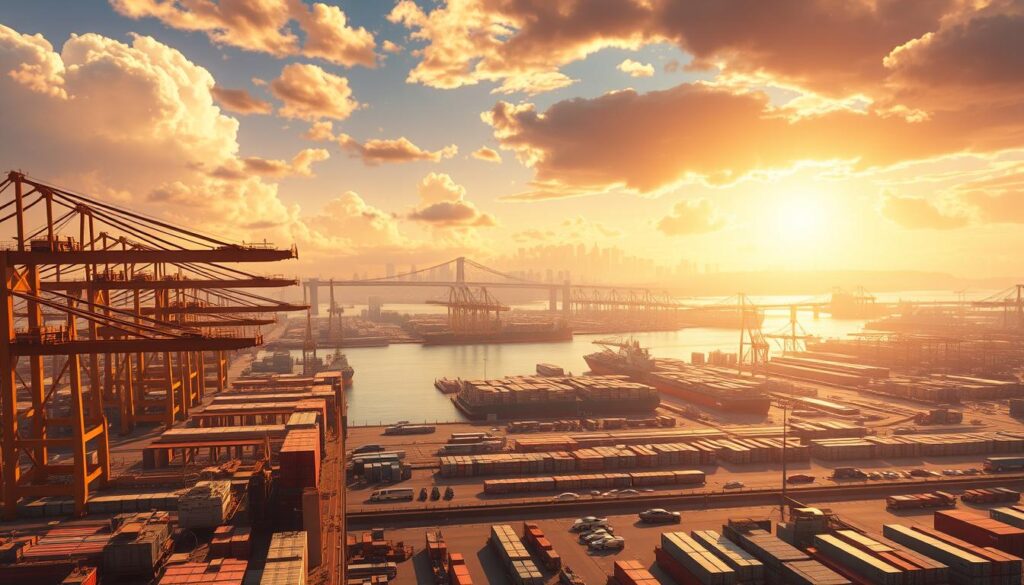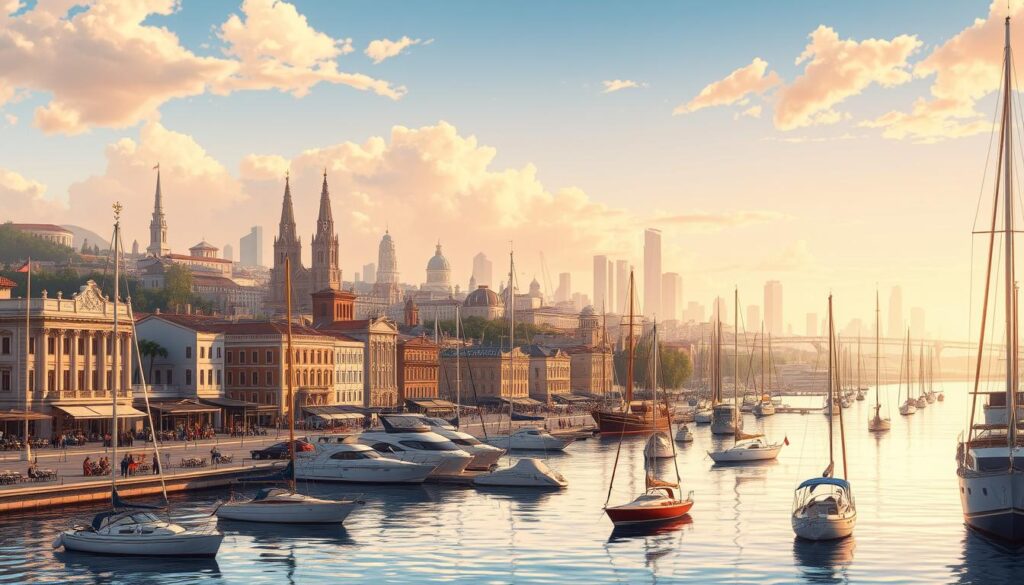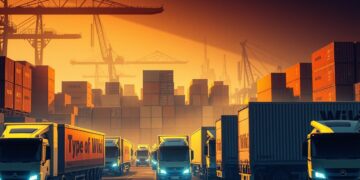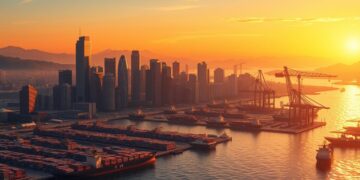Did you know that over 80% of global trade is helped by port cities? These places are key for international trade and sharing cultures. They help grow the economy and bring people together.
We’re going to look at how port cities are important for trade and tourism. You’ll learn about the five main types that connect countries and continents. This will help you understand how trade works and the big role maritime towns play in our world.
Key Takeaways
- Port cities facilitate over 80% of global trade.
- Maritime towns drive economic growth and cultural diversity.
- Five key models of port cities will be explored.
- Understanding these models provides insights into global trade dynamics.
- Port cities are crucial links between nations and continents.
Introduction to Port Cities
A city with a harbor is more than a place. It’s a key spot for global trade. For centuries, port cities have helped move goods and services around the world.
These cities mix culture and economy in a unique way. They are interesting places to visit. Let’s look at what makes port cities important for trade and tourism.
Definition of a Port City
A port city, or waterfront city, has a harbor for ships. Dr. Theo Notteboom, Dr. Jean-Paul Rodrigue, and Dr. Athanasios Pallis say these cities offer economic chances. They connect to global supply chains.
These cities are not just about money. They are places where different cultures meet. The harbor has shaped their buildings, culture, and identity.
“Port cities are gateways to the world, facilitating the flow of goods, services, and ideas across the globe.”
Importance in Global Trade
Port cities are key in global trade. They help move goods and connect makers with buyers. They also boost local and national economies by creating jobs and making money.
| Aspect | Description | Impact |
|---|---|---|
| Economic Contribution | Job creation and revenue generation | Significant contribution to local and national economies |
| Global Connectivity | Facilitates international trade | Enhances global supply chain efficiency |
| Cultural Exchange | Promotes cultural diversity | Enriches the cultural landscape of the city |
Role in Tourism
Port cities are also big tourist spots. They offer culture, history, and fun by the water. Visitors can see museums, try food, and enjoy the waterfront.
Port cities are more than just economic centers. They are lively places for culture, tourism, and business. They shape trade and tourism in big ways.
Historical Significance of Port Cities
Port cities have been key for trade, innovation, and cultural exchange for ages. These coastal cities have shaped human history. They helped exchange goods, ideas, and cultures between civilizations.
Port cities evolved due to technology, trade changes, and empire rise and fall. They adapted and changed, leaving a lasting mark today.
Evolution Through the Ages
Port cities’ history goes back thousands of years. Ancient places like Greece and Rome had them. These harbor cities helped their regions grow economically and culturally.
As trade patterns changed, new port cities grew, while old ones faded. European powers’ rise in the Age of Exploration led to new trade routes. This boosted port cities in the Mediterranean and Baltic.
Key Historical Port Cities
Some port cities greatly influenced global trade and commerce. Amsterdam, Singapore, and Hong Kong were major commercial centers. They connected regions and exchanged goods and ideas.
| Port City | Historical Significance | Notable Features |
|---|---|---|
| Amsterdam | Major trading hub during the Dutch Golden Age | Canals, historic architecture |
| Singapore | Strategic location on major shipping routes | Modern infrastructure, diverse culture |
| Hong Kong | Gateway to China and Asia | Iconic skyline, vibrant economy |
Influence on Trade Routes
Port cities have not only helped trade but also shaped trade routes. New shipping lanes and port growth made global goods transport easier.
Port cities’ importance goes beyond economics. They’ve also shaped cultural heritage and promoted cultural exchange.
Types of Port Cities
Port cities come in many shapes and sizes. They range from big seaports to small coastal towns and fishing ports. Each has its own special features and ways of making money. Their variety is a big plus for trade and tourism worldwide.
Major Seaport Cities
Major seaport cities are huge in global trade. They handle lots of cargo and are key for international business. These cities are often by rivers or in natural harbors, making them big economic spots. For example, Rotterdam and Singapore are both big seaports and estuary cities, where rivers meet the sea.
These cities have top-notch infrastructure, like big container terminals and logistics facilities. They draw businesses and people from everywhere, boosting their economy.
Small Coastal Towns
Small coastal towns are quieter and more beautiful than big seaports. They have a deep maritime history and might focus on certain cargo or tourism. Even though they’re smaller, they’re key for local trade and fishing.
Some small coastal towns are becoming tourist spots. They use their beauty and history to attract visitors. This can bring in new money and help keep their unique feel.
Fishing Ports
Fishing ports are vital, with their economies based on fishing. They can be small local docks or big commercial fishing spots. The health of these ports depends on the sea and fishing methods.
Many fishing ports are also starting to attract tourists. Visitors come for fresh seafood, the sea culture, and the views. This mix can help these places stay strong for a long time.
| Type of Port City | Primary Economic Activity | Notable Characteristics |
|---|---|---|
| Major Seaport Cities | International Trade and Commerce | Sophisticated infrastructure, global connectivity |
| Small Coastal Towns | Regional Trade, Tourism, Fishing | Picturesque landscapes, historical significance |
| Fishing Ports | Fishing Industry | Fresh seafood, maritime culture |
Economic Impact of Port Cities
Port cities are key players in international trade and tourism. They boost economic growth. Their strategic spots help in moving goods in and out, affecting local and national economies.
Contribution to Local Economies
Port cities are big economic drivers. They grow through many sectors. They also boost local economic activity.
A study shows, “port cities’ economic benefits go beyond trade. They also include tourism, recreation, and cultural exchange.”
“The port city is a unique economic entity that combines the functions of a transport hub, an industrial center, and a tourist destination.”
Building port infrastructure attracts investment and creates jobs. This helps the local economy and improves life for residents.
Job Creation Opportunities
Nautical cities or port cities create many jobs. They offer jobs in dockwork, shipping, tourism, and more. This means there are jobs for all skill levels, helping keep unemployment low.
Also, growing port industries lead to more jobs. This boosts the local economy. More people with money to spend help demand for goods and services grow.
Revenue from Tourism
Tourism is a big part of port cities‘ economies. Visitors come for the culture, history, and fun activities. Cruise ships bring lots of tourists, spending money on places to stay, eat, and play.
Tourism money helps keep historical sites safe and improves infrastructure. This makes the tourist experience better. It also brings more visitors, creating a cycle of growth.
Environmental Considerations for Port Cities
Port cities are key for global trade and tourism. They face big environmental challenges. These cities are not just economic centers but also affect the environment a lot.
Sustainability Challenges
One big worry for port cities is being sustainable. They need to grow their economy while protecting the environment. Sustainable practices are being used to lessen their environmental impact. For example, some cities are using renewable energy for their operations.
Using sustainable practices helps the environment and improves life for locals. It also makes the city more appealing to tourists and businesses.
Ecological Impact of Shipping
Shipping is vital for port cities’ economies but harms the environment. Ship emissions pollute the air and contribute to global warming.
To lessen this harm, ports are setting stricter emission rules. They’re also encouraging ships to use cleaner fuels. For instance, some ports offer discounts for ships using liquefied natural gas (LNG) or other green fuels.
Coastal Protection Efforts
Protecting the coast is crucial for port cities. Climate change causes sea levels to rise and storms to get stronger. This threatens coastal buildings and nature.
To fight these threats, cities are building sea walls, dunes, and restoring wetlands. These actions protect the city and keep natural habitats safe.
| Environmental Challenge | Impact | Mitigation Strategy |
|---|---|---|
| Shipping Emissions | Air Pollution, Climate Change | Stricter Emissions Regulations, Alternative Fuels |
| Coastal Erosion | Loss of Land, Infrastructure Damage | Coastal Protection Measures, Wetland Restoration |
| Pollution | Environmental Degradation, Health Risks | Waste Management, Pollution Controls |
“The health of our oceans is closely tied to the health of our port cities. By adopting sustainable practices and reducing pollution, we can create a healthier environment for both.”
Port Infrastructure and Development
A well-developed port infrastructure is key for moving goods and people efficiently. As global trade grows, investing in ports is vital. We’ll look at port infrastructure, modern technology, and future trends in harbor cities.
Types of Facilities Needed
Port cities need different facilities to work well. These include:
- Efficient Cargo Handling Systems: Modern cranes and conveyor systems for quick and safe cargo handling.
- Storage Facilities: Warehouses and container yards for secure storage of goods.
- Navigation and Safety Equipment: Advanced navigation aids like GPS and radar for safe vessel passage.
These facilities are key for smooth goods flow and local economy support. For example, a city with a harbor with modern cargo systems can cut transit times and boost global trade competitiveness.

Modern Technological Innovations
Modern tech is changing port infrastructure. Key advancements include:
- Automation and Robotics: Automated cranes, robots, and drones for better efficiency and lower costs.
- Data Analytics: Big data and analytics for better port operations, maintenance prediction, and security.
- Green Technologies: Sustainable technologies like shore power and electric cranes to lessen environmental impact.
These technologies boost port efficiency and make harbor cities more appealing and sustainable.
Future Trends in Port Development
Several trends will shape port development’s future. These include:
- Increased Focus on Sustainability: Ports will need to reduce their environmental impact with green technologies and practices.
- Integration with Global Supply Chains: Ports will need to work closer with global supply chains, using data and tech for better goods flow.
- Adaptation to Climate Change: Ports will need to adapt to climate change impacts like rising sea levels and extreme weather.
By embracing these trends, harbor cities can stay competitive and sustainable in a changing global economy.
Examples of Prominent Port Cities in the U.S.
The United States has many port cities that are key in global trade and tourism. These cities are important for their economy and culture. They also have a rich history.
New York City: A Gateway to the World
New York City is one of the busiest ports in the world. It’s a major gateway for international trade. The Port of New York and New Jersey handles a lot of the country’s imports and exports.
New York City is also a cultural melting pot. It attracts tourists from all over the world.
San Francisco: Technology Meets Trade
San Francisco is known for its Port of San Francisco. It’s a mix of technology and trade. The port supports cargo handling and cruise tourism.
San Francisco is a global leader in technology and innovation. It’s more than just a port city.
New Orleans: Cultural and Economic Hub
New Orleans is famous for its vibrant culture and history. The Port of New Orleans is a major cargo hub, especially for agricultural exports. The city’s culture and economy make it special.
Here’s a look at these port cities:
| City | Primary Economic Activity | Cultural Significance |
|---|---|---|
| New York City | International Trade | Cultural Melting Pot |
| San Francisco | Technology and Trade | Innovation Hub |
| New Orleans | Agricultural Exports | Vibrant Cultural Heritage |
These examples show how port cities are important in the U.S. They help with global trade and add to our culture. Their impact goes beyond just economics.
Port Cities and Cultural Exchange
Port cities are full of life, where different people come together. They create a special city vibe. These places have always been gateways to the world. They draw people from everywhere, making a unique culture.
Diversity and Multiculturalism
Port cities show off their diverse cultures. Places like Singapore and Hong Kong mix East and West. This makes a rich cultural mix. Learn more about these cities in our article on five enchanting cities on the water.
Festivals and Events
Port cities celebrate their diversity with festivals and events. For example, the New Orleans Jazz Festival shows the city’s rich culture. It mixes African, French, and American traditions. These events entertain and teach about the city’s culture.
Influence on Local Cuisine
The mix of cultures in port cities affects their food. For example, Barcelona’s food is a mix of seafood and Mediterranean tastes. This shows the city’s sea history and cultural exchanges.
In short, port cities are more than just economic hubs. They are cultural melting pots. Their diverse cultures, lively festivals, and special foods make them exciting places to visit.
Tourism Opportunities in Port Cities
Port cities are gateways to the world. They offer a mix of culture and fun. You can learn about maritime history, enjoy the water, or try local food. There’s something for everyone in these lively cities.
Waterfront Attractions and Activities
Waterfronts in port cities are full of life. You can walk along the promenade, visit a marina, or eat at a restaurant. These places also host events like sailing races and seafood festivals.

Historical Tours and Museums
Port cities have a rich history. You can learn about it through tours and museums. Tours show you important landmarks and events from the past.
Museums in these cities have exhibits on maritime history and trade. You can see how shipping and trade routes have changed. Learning about port city relationships adds to their historical value.
Culinary Tourism in Port Cities
Culinary tourism is big in port cities. Visitors love the mix of local and international foods. You can try fresh seafood, traditional dishes, or go on food tours.
These cities have unique foods shaped by their trade and cultural history. You might taste dishes that blend local and international flavors. Food tours are a great way to learn about the city’s culture and history.
Challenges Facing Port Cities
As the world’s population grows, port cities face big challenges. These cities are key for global trade and tourism. They must deal with many issues to stay strong and sustainable.
Urbanization and Congestion
Urbanization and congestion are big problems for port cities. More people in cities strain the infrastructure. This causes more traffic, higher living costs, and stress on local services.
For example, San Francisco must balance its residents, businesses, and tourists. It also needs to keep its famous harbor in good shape.
Ports themselves can get very busy, causing delays and higher costs. Good planning and new infrastructure are key to solving these problems.
Environmental Degradation
Environmental degradation is another big challenge. The shipping industry pollutes a lot, harming the climate, air, and water. Port cities must use green practices to lessen their impact.
For instance, the Port of Rotterdam is working hard to be carbon neutral by 2050. Such efforts are vital for the future of harbor cities.
Competition Among Global Ports
Port cities also face competition from other global ports. To stand out, they need to be efficient, offer new services, and have a good location. This competition pushes them to improve and invest in new tech.
To stay ahead, harbor cities must update their facilities and use the latest technology. This makes them more attractive to shippers and businesses, boosting their economy.
Case Studies of Successful Port Cities
Many port cities worldwide have become leaders in trade and tourism. They use their strengths to drive global success. These cities have come up with new strategies, improved their infrastructure, and used their locations to the fullest.
Rotterdam: Efficiency and Innovation
The Port of Rotterdam stands out for its efficiency and innovation. It’s one of the busiest ports globally. It uses the latest technology to make operations smoother and cut down on pollution.
Rotterdam has also focused on digital infrastructure. It has advanced logistics systems and tools for real-time monitoring. This helps it run more efficiently.
Singapore: Strategic Location and Trade
Singapore is a top port city thanks to its strategic location. It’s a major trade hub. Its port is very busy and efficient, thanks to its location and focus on innovation and service.
Singapore keeps up with trade changes and invests in new port infrastructure. This has helped it stay ahead.
Hong Kong: Gateway to Asia
Hong Kong is a key port city, a gateway to Asia for trade. Its success comes from a great business environment, top-notch infrastructure, and location. The Hong Kong International Container Terminal is a key part of its port. It offers the latest equipment and efficient operations for global shipping lines.
These examples show that success in port cities comes from planning, investing in infrastructure, and innovation. By learning from these, other cities can improve their place in the global maritime industry.
Future of Port Cities
Global trade and tourism are changing fast. Port cities must adapt to these changes and use green practices. Cities like Rotterdam and Amsterdam are leading the way with their smart city plans.
Adapting to a Changing Economy
Port cities need to be strong when the economy changes. They can do this by growing their economy and updating their infrastructure. For example, Malmö has turned old harbour areas into green homes and mixed-use spaces.
Sustainable Practices in Nautical Cities
Being green is key for port cities to thrive. They should use new green tech, cut down on pollution, and support eco-friendly tourism. Rotterdam is a great example of a city that’s going green and caring for its people.
Predictions for the Next Decade
In the next ten years, port cities will keep growing. They will be shaped by new tech and shifts in global trade. For more on what’s coming, check out the Leiden-Delft-Erasmus Centre. They have lots of info on how port cities will change in the future.



















